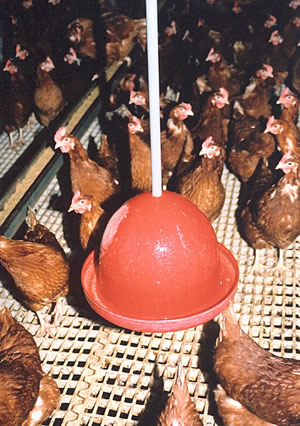
Water is essential for life. That applies to us as much as to our chickens! Providing ample amounts of fresh clean water is needed to maintain the health and performance of our birds. However, that same water can also be the villain. Water can carry many of the bugs we worry about most, such as E.coli, Salmonella and Campylobacter. A survey in the USA showed that 88% of water systems on poultry farms sampled in the Delmarva Peninsula contained significant bacterial contamination. Bacteria in feed particles, dust, litter, faeces and nasal or mouth discharges can easily contaminate open drinkers such as bell drinkers. This can then act as an efficient focus to infect other birds. A useful analogy would be that you would not wish to share a cup with someone with flu! Obviously, then, providing your birds with clean, bug free water can have a significant impact on their health and welfare. The first precaution is to try and create a closed water system to reduce contamination in the first place.
A close fitting lid to the header tank can have many benefits. The lid helps to exclude:
· Dust which may carry many micro-organisms.
· Light which would encourage mould and algal growth.
· Birds and rodents which may carry micro-organisms.
However, especially in bell drinker systems, water at the bird level may still have a high total bug count. This may be because of primary contamination of the water source, residual contamination in the water system due to an ineffective sanitisation at flock depopulation, or ongoing contamination during the life of the flock.
Another aspect that has received much attention recently is the phenomenon of biofilms. An important part of the life cycle of many micro-organisms is their ability to attach and hang on to surfaces. This results in biofilm formation. Biofilms exist in all water and plumbing systems at temperatures below 60 °F and results in the production of copious amounts of exopolysaccharides (sticky chemicals!) which are excreted by the bacteria clinging to the surfaces. Problems associated with biofilms are not just restricted to the poultry industry. Such biofilms are important triggers for plaque on teeth, corrosion in the engineering and building industries and the persistence of Legionnaires disease in water cooling systems. It is easiest to understand a biofilm simply as sludge in which bacteria can hide. They are, in fact, more complex structures involving a honeycomb of cracks and crevices in which bacteria thrive with water percolating through supplying a source of oxygen and nutrients. The biofilm provides a haven for water borne pathogens including E.coli, Salmonella, Pseudomonas and Campylobacter. These can then be protected from extremes of water chemistry, temperature and many disinfectants. Although water entering such a system may have little contamination, the presence of biofilms will compromise the quality of the water that the birds then drink. It is likely that any low level of Salmonella contamination in a flock will be rapidly spread by a water system. Although Salmonella may be a rarity in our flocks these days, E.coli is certainly still likely to be present. As discussed in previous editions of The Ranger, the bacteria, E.coli, is at the root of many problems, especially peritonitis.
The risk of water borne infections must therefore be controlled by choosing a disinfectant which has proven efficacy against the organisms we are worried about and also be capable of penetrating or removing the protective biofilm. Historically, chlorine based products have been advocated for water sanitisation, for birds and people alike, but recent work suggests that they are not very effective at penetrating biofilms. A number of products have been recommended as acidifiers and disinfectants for water systems at flock depletion and for continuous sanitising during the life of the flock. Your veterinary surgeon will be able to recommend the product most suitable for your system. Don’t forget to choose a product which has been shown by independent testing to kill the bacteria you are worried about, as well as helping to remove the biofilm. The main points to consider when attempting to control the risk of water borne infections for your flock are as follows:
· Maintain a closed water system with a well fitting lid to exclude light, vermin and dust.
· Ensure that the whole water system, header tank, pipework and drinkers are emptied, cleaned and sanitised at terminal disinfection.
· Replace all rusting or pitted metal pipework in header tanks with new smooth high quality alkathene piping with minimal joints and junctions which may harbour bacteria or promote biolfilm formation.
· Choose a disinfectant with proven efficacy against bacteria likely to colonise water systems and the capacity to remove the protective biofilm from the internal surfaces of the water system.
· Where there is any concern about the bacterial load of drinking water from source or in the system, use a continuous water sanitiser during the life of the flock.
Conclusions
Remember that water is essential for life. This applies to you and your birds, but also to the bacteria which love to colonise water systems. Don’t give these organisms the upperhand but maintain a clean, closed system. Use a disinfectant which you know will remove the dreaded biofilm and kill the offending bacteria to ensure that your water system does not become the Achilles heel of your biosecurity programme.
